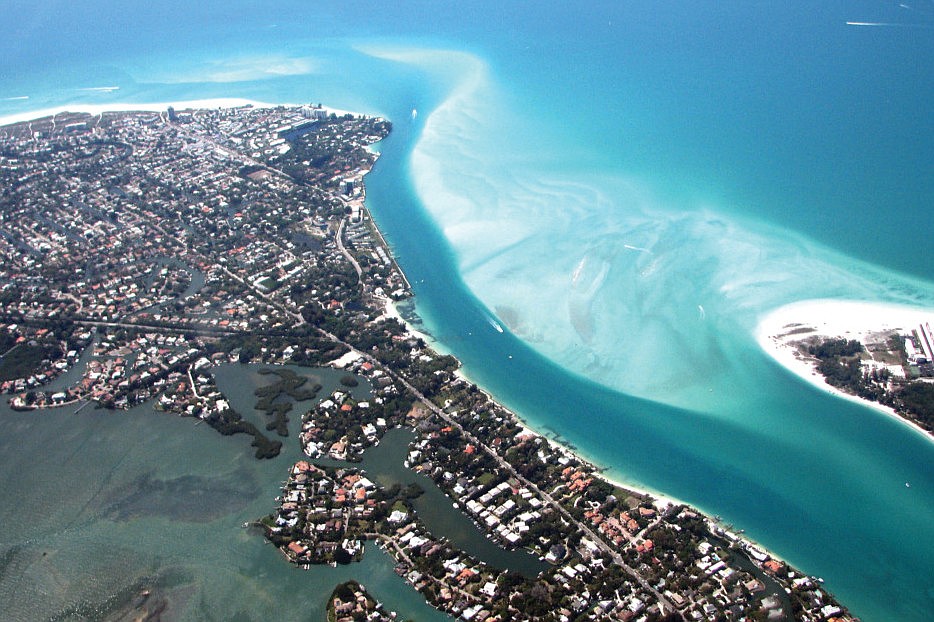- April 29, 2025
-
-
Loading

Loading

Big Pass, the inlet north of Siesta Key, has never been dredged.
That could change if the city of Sarasota and the U.S. Army Corps of Engineers choose the inlet as the sand source for the Lido Beach restoration.
“The U.S. Army Corps of Engineers is trying to get a contractor out for core samples to see how feasible that would be,” said Sarasota County Coastal Resources Manager Laird Wreford during a Jan. 17 phone interview with the Pelican Press. Corps spokeswoman Amanda Ellison confirmed the federal agency is using computer modeling to determine if Big Pass is a viable borrow source.
Dredging is the act of removing sand from waterways so boaters can more easily navigate them or removing it from a specific location for use in beach nourishment.
In this case, the main purpose of dredging would be to harvest sand to mitigate erosion damage on Lido, but dredging could also have a secondary effect of, at least temporarily, making the inlet more navigable.
The U.S. Coast Guard doesn’t recognize the volatile Big Pass as a navigable waterway, because it so frequently shifts in different directions. Volunteers from the Sarasota Yacht Club and Sarasota County Coastal Resources staff place markers so boaters can safely navigate the pass.
The Corps could combine the borrow dredge with a navigational dredge to give boaters easier access through the inlet. A navigational dredge would target certain parts of the inlet to create an efficient channel for boaters.
“It’s not rocket science,” said Cliff Truitt, whose firm, Coastal Technology Corp., analyzed Big Pass from 2007 through 2010.
Estimates from the 2007 Siesta Key renourishment project revealed the county could have saved $10 million by harvesting Big Pass instead of performing a sand search and borrowing from a site 10 miles offshore.
“Safeguard our shoreline from any proposals to dredge Big Pass that may negatively impact our beaches” is listed as one of the Siesta Key Association’s ongoing goals.
Siesta residents in 1993 formed Save Our Sand, a group that successfully blocked a city of Venice plan to harvest Big Pass sand. SKA stalled a similar proposal in 2007.
At least 20 million cubic feet of sand compose the shoals in Big Pass according to an estimate by Truitt.
The study concluded that the sand was viable to be used for Lido Beach renourishment and that as the shoals adjacent to Big Pass continue to grow it could accelerate erosion on Siesta Key. However, a navigation channel cut through the shoals would fill in within the year, Truitt said.
“It’s all the same problem — sand is accumulating in Big Pass,” Truitt said.
On the west coast of Florida, sand migrates naturally southward creating erosion on beaches along the way.
Sarasota County residents and municipalities in the past have built concrete groins, or jetties, to slow sediment’s southern drift. But, the Army Corps of Engineers and the Florida Department of Environmental Protection are restrictive in permitting such solutions because of the unpredictable environmental effects.
It is similarly difficult to predict the environmental effects of dredging Big Pass, which the Siesta Key Association has fought when the proposal surfaces.
“The thought is you could actually relieve erosional impact by taking sand out of (Big Pass),” Wreford said.
The Corps of Engineers, before making a decision on Big Pass, will take vibracore samples, which are 20 foot long, cylindrical cross-sectional views of the seabed at a potential borrow site. Then it analyzes sediment grain size, shell content and color to ensure it is a suitable match for Lido Key sand.
The core samples would come from shoals, so boaters not be affected.
The FDEP requires color-matching to assure similarity of temperatures of sea turtle nests from year-to-year. Darker sand gets hotter than lighter sand, and some studies have shown this to affect hatchling sex ratios.
“All of this is very preliminary,” Wreford said.